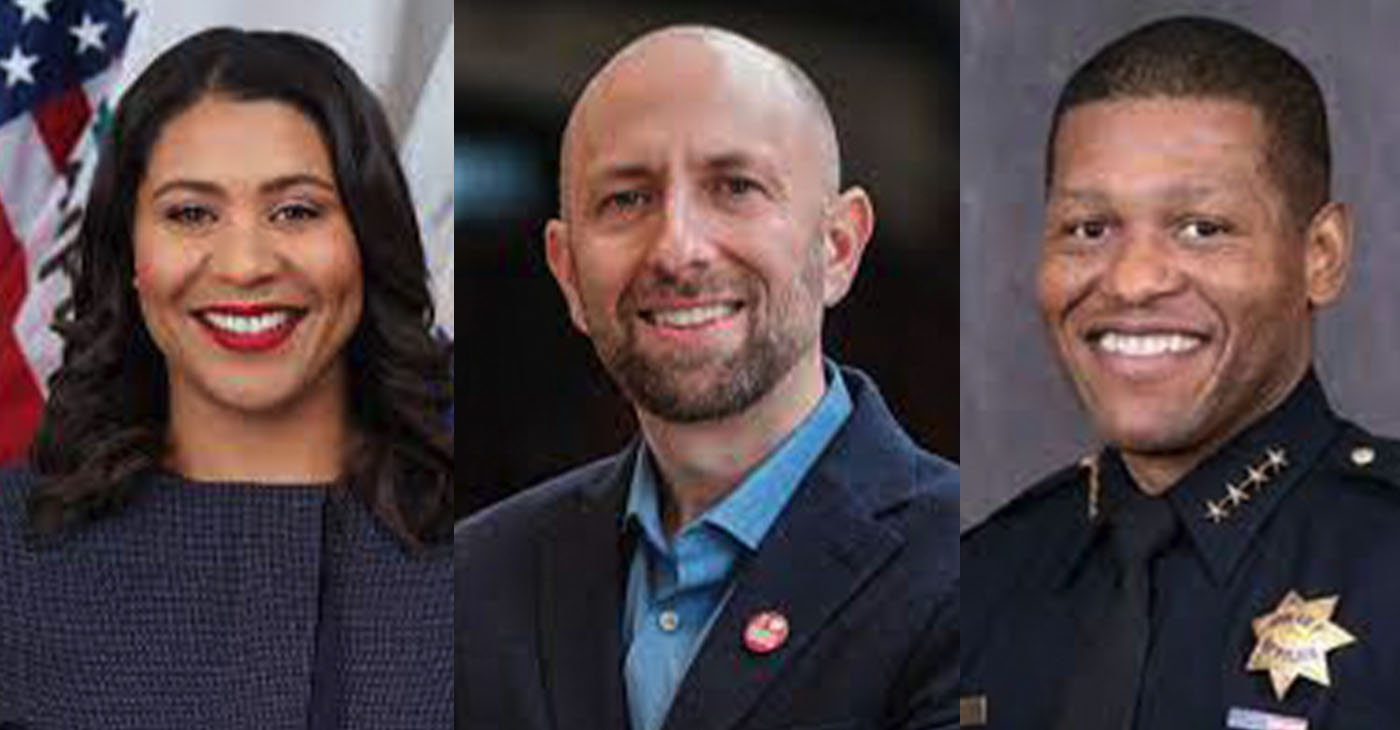Bay Area
Westside Residents and Business Owners Rally to Support of Mayor Breed’s Public Safety Budget
Westside residents and small business owners rallied Tuesday in support of Mayor London Breed’s public safety budget proposal that is currently before the Board of Supervisors, which is in final budget deliberations over the next few days. The Mayor’s Budget focuses on key areas of public safety, including building back police staffing, expanding alternatives to policing, and shutting down open-air drug markets.

Westside community members called for the approval of funding focused on rebuilding police staffing and tackling the City’s public safety challenge
Mayor’s Office of Communications
Westside residents and small business owners rallied Tuesday in support of Mayor London Breed’s public safety budget proposal that is currently before the Board of Supervisors, which is in final budget deliberations over the next few days. The Mayor’s Budget focuses on key areas of public safety, including building back police staffing, expanding alternatives to policing, and shutting down open-air drug markets.
Public safety investments are part of the City’s recovery efforts, including in westside neighborhoods where residents face safety challenges around residential, commercial, and vehicular break-ins. The Sunset District also has seen the most catalytic converter thefts in the City.
“Our residents and small businesses and neighborhoods across the City, including the Westside, are calling for more support for public safety which is why is critical for my public safety proposal to pass,” said Breed. “We must invest in public safety initiatives, including building back our police department staffing, expanding police alternatives, and holding people accountable by disrupting open-air drug sales in the City.”
“Sunset residents experience the most catalytic converter thefts in the city and our police station has one of the greatest shortage of officers. We need to invest in enough police officers for a city our size, so every neighborhood has the protection it deserves. We should also invest in policing alternatives that can let officers focus on serious crimes,” said Supervisor Joel Engardio, who represents the Sunset neighborhoods of District 4.
“A healthy and functioning city cannot allow an open drug market. No resident should have to pass through misery and mayhem on their way to work or school,” Engardio continued. “That’s why it’s important to fund the coordination of local, state, and federal public safety agencies to end the dealing of deadly fentanyl and provide users with life-saving treatment.”
At the rally, residents and small businesses, in addition to calling out the need for public safety citywide, focused on neighborhood issues like residential, commercial and vehicular break-ins.
The Mayor’s Budget was introduced to the Board of Supervisors on June 1. Currently, the Board is holding hearings in the Budget and Finance Committee which is set to pass a final budget this week.
Building Back Our Police Force
San Francisco has seen an increase in applications for the Police Department over the last six months, with levels reaching interest not seen since 2018. This is welcomed news after recent struggles to fill Academy classes. To take advantage of this growing interest in SFPD, the Mayor’s Budget:
- Funds 220 new officers over the next two years, with a goal of reaching 1,800 sworn officers this year. This is part of a multi-year strategy to reach full staffing in the next five years.
- Supports the recently approved contract to make San Francisco the highest paid starting salary for officers in the Bay Area.
- Sets dynamic Academy class goals so that the Department is ready to start classes as they fill.
- Supports SFPD recruitment efforts to conduct various outreach strategies, improve the application process, and continue to add resources dedicated to recruiting.
“San Francisco is at a turning point. We cannot afford to lose the valuable progress we’ve made in increasing public safety and holding people who commit harm accountable,” said Police Chief Bill Scott. “We’re working hard to build on the success we’ve had in hiring more officers, expanding our civilian ambassadors, and taking deadly drugs off the streets.”
Expanding Alternatives to Policing
San Francisco continues to be a leader in moving non-law enforcement work away from police officers to provide a more appropriate response, and to free up our officers to focus on crime and safety issues.
- Expanding civilianization staffing by funding 22 new Police Service Aides, who assist with administrative duties and write and file reports on low-priority incidents.
- Continuing call diversion efforts, including funding for the Street Response Teams.
- Maintaining the current level of ambassadors in the City, including recent expansions. This includes SFPD Community Ambassadors (retired police officers), Urban Alchemy in the Tenderloin and Mid-Market; Welcome Ambassadors in Downtown and tourist areas; BART attendants in Downtown transit stations, and the Mission Ambassadors.
Closing Down Open-Air Drug Markets
San Francisco has prioritized shutting down open-air drug markets to remove the harm it causes in our neighborhoods and for those struggling with addiction. This has been paired with expanded treatment and services through our Department of Public Health and other outreach programs.
The budget funds the recent expansion of prosecutors in the District Attorney’s Office dedicated to targeting drug dealing and contains funding for a coordinated city effort led by the Department of Emergency Management to shut down the City’s open-air drug markets.
This effort will focus on three key areas: open drug sales, public drug use, and illegal fencing of stolen goods in the drug market areas.
“The mayor’s proposed budget provides much needed resources that will improve our ability to close open-air drug markets, and hold suspected drug dealers accountable,” said District Attorney Brooke Jenkins. “I am grateful to the mayor for prioritizing public safety and addressing the most urgent needs facing our communities.”
“We need accountability with compassion if we are going to solve San Francisco’s drug crisis,” said Sheriff Paul Miyamoto. “Between SFPD’s arrests on the street and the SFDA’s prosecutions in the courtroom, the Sheriff’s Office stands right in the middle; whether a person is in jail or supervised out of custody, we have to lead those suffering from addiction into sobriety and rehabilitation. Some people volunteer to get better –others need to be compelled. Our deputies are here to facilitate both.”
As part of this effort:
- SFPD, the Sheriff, and the District Attorney will coordinate with state and federal law enforcement partners to identify and arrest drug dealers and traffickers, disrupt the supply chain, and reduce the profitability of this criminal operation;
- SFPD and the Sheriff are coordinating to arrest and detain those who pose a danger to themselves and to others. Anyone detained in our jails is supported by Jail Health Services and offered access to voluntary services upon release. At the same time, city health and homelessness outreach workers will continue the proactive outreach in targeted neighborhoods, offering a wide range of public health and homelessness services to those on our streets;
- SFPD will enforce against illegal sales of stolen goods and support Public Works’ inspection efforts, confiscation, and other enforcement against vending in violation of our existing lawful street vending program.
- “As a longtime volunteer community activist, I applaud Mayor Breed’s upcoming budget to focus on public safety,” said Marlene Tran, Visitation Valley community leader. “Her planned investments in long-term police hiring and maintaining ambassador programs are very sound priorities. Closing down open drug markets will save many lives and increase public safety. In addition, for justice to prevail, more resources for the important work of the District Attorney’s Office to prosecute the wide range of crimes is welcome news.”
- “Our organization fully supports these public safety efforts put forth by Mayor Breed,” said Frank Noto and Eric Chang, president and vice president of Stop Crime SF. “We need to address safety issues from all angles, and this includes making sure our police department is adequately staffed, supporting and expanding alternatives to policing, and disrupting the open-air sales of dangerous drugs.”
- “The ambassadors who are retired police officers have been so great with engaging our merchants and residents, making sure they feel safe and are connected with resources,” said Bill Barnikel, president of Outer Sunset Merchant Professional Association. “I want to thank Mayor Breed and Supervisor Engardio for making sure that their public safety efforts are consistent with the west side of the City.”
“Safety is a vital priority for the Chinese community. The Sunset Chinese Cultural District and Wah Mei School have been proud to work with Supervisor Engardio on community engagement through a Night Market and other events to bring community together. Events offer an alternative to policing and is one of many solutions to bring joy and foster a sense of community,” said Lily Wong, director of Community Engagement at Wah Mei School and Sunset Chinese Cultural District director.
Activism
Oakland Post: Week of May 21 – 27, 2025
The printed Weekly Edition of the Oakland Post: Week of May 21 – 27, 2025

To enlarge your view of this issue, use the slider, magnifying glass icon or full page icon in the lower right corner of the browser window.
Bay Area
Chevron Richmond Installs Baker Hughes Flare.IQ, Real-time Flare Monitoring, Control and Reduction System
While the sight of flaring can cause concern in the community, flares are essential safety systems that burn pollutants to prevent them from being released directly into the atmosphere. They activate during startup and shut-down of facility units or during upsets or equipment malfunctions. The typical flare stack is about 200 feet high so that vapors are well above street levels.

The Richmond Standard
Chevron Richmond recently installed flare.IQ, a real-time, automated system that will improve the facility’s flaring performance.
The technology, developed by Panametrics, a Baker Hughes business, uses sensors to monitor, reduce and control flaring in real time. It collects and assesses data on refinery processes, such as temperature, pressure, gas flow and gas composition, and adjusts accordingly to ensure flares burn more efficiently and cleanly, leading to fewer emissions.
“The cleaner the flare, the brighter the flame can look,” said Duy Nguyen, a Chevron Richmond flaring specialist. “If you see a brighter flame than usual on a flare, that actually means flare.IQ is operating as intended.”
While the sight of flaring can cause concern in the community, flares are essential safety systems that burn pollutants to prevent them from being released directly into the atmosphere. They activate during startup and shut-down of facility units or during upsets or equipment malfunctions. The typical flare stack is about 200 feet high so that vapors are well above street levels.
“A key element in Baker Hughes’ emissions abatement portfolio, flare.IQ has a proven track record in optimizing flare operations and significantly reducing emissions,” said Colin Hehir, vice president of Panametrics, a Baker Hughes business. “By partnering with Chevron Richmond, one of the first operators in North America to adopt flare.IQ, we are looking forward to enhancing the plant’s flaring operations.”
The installation of flare.IQ is part of a broader and ongoing effort by Chevron Richmond to improve flare performance, particularly in response to increased events after the new, more efficient hydrogen plant was brought online in 2019.
Since then, the company has invested $25 million — and counting — into flare minimization. As part of the effort, a multidisciplinary refinery team was formed to find and implement ways to improve operational reliability and ultimately reduce flaring. Operators and other employees involved in management of flares and flare gas recovery systems undergo new training.
“It is important to me that the community knows we are working hard to lower emissions and improve our flaring performance,” Nguyen said.
Also evolving is the process by which community members are notified of flaring incidents. The Community Warning System (CWS), operated by Contra Costa County is an “all-hazard” public warning system.
Residents can opt-in to receive alerts via text, e-mail and landline. The CWS was recently expanded to enable residents to receive notifications for “Level 1” incidents, which are considered informational as they do not require any community action.
For more information related to these topics, check out the resources included on the Chevron Richmond, CAER and Contra Costa Health websites. Residents are also encouraged to follow @chevronrichmond and @RFDCAOnline on Facebook and X (formerly Twitter), where additional information may be posted during an incident.
Activism
Oakland Hosts Town Hall Addressing Lead Hazards in City Housing
According to the city, there are 22,000 households in need of services for lead issues, most in predominantly low-income or Black and Latino neighborhoods, but only 550 to 600 homes are addressed every year. The city is hoping to use part of the multimillion-dollar settlement to increase the number of households served each year.

By Magaly Muñoz
The City of Oakland’s Housing and Community Development Department hosted a town hall in the Fruitvale to discuss the efforts being undertaken to remove lead primarily found in housing in East and West Oakland.
In 2021, the city was awarded $14 million out of a $24 million legal settlement from a lawsuit against paint distributors for selling lead-based paint that has affected hundreds of families in Oakland and Alameda County. The funding is intended to be used for lead poisoning reduction and prevention services in paint only, not water or other sources as has been found recently in schools across the city.
The settlement can be used for developing or enhancing programs that abate lead-based paint, providing services to individuals, particularly exposed children, educating the public about hazards caused by lead paint, and covering attorney’s fees incurred in pursuing litigation.
According to the city, there are 22,000 households in need of services for lead issues, most in predominantly low-income or Black and Latino neighborhoods, but only 550 to 600 homes are addressed every year. The city is hoping to use part of the multimillion-dollar settlement to increase the number of households served each year.
Most of the homes affected were built prior to 1978, and 12,000 of these homes are considered to be at high risk for lead poisoning.
City councilmember Noel Gallo, who represents a few of the lead-affected Census tracts, said the majority of the poisoned kids and families are coming directly from neighborhoods like the Fruitvale.
“When you look at the [kids being admitted] at the children’s hospital, they’re coming from this community,” Gallo said at the town hall.
In order to eventually rid the highest impacted homes of lead poisoning, the city intends to create programs and activities such as lead-based paint inspections and assessments, full abatement designed to permanently eliminate lead-based paint, or partial abatement for repairs, painting, and specialized cleaning meant for temporary reduction of hazards.
In feedback for what the city could implement in their programming, residents in attendance of the event said they want more accessibility to resources, like blood testing, and information from officials about lead poisoning symptoms, hotlines for assistance, and updates on the reduction of lead in their communities.
Attendees also asked how they’d know where they are on the prioritization list and what would be done to address lead in the water found at several school sites in Oakland last year.
City staff said there will be a follow-up event to gather more community input for programming in August, with finalizations happening in the fall and a pilot launch in early 2026.
-

 #NNPA BlackPress3 weeks ago
#NNPA BlackPress3 weeks agoMLK Bust Quietly Removed from Oval Office Under Trump
-

 Activism4 weeks ago
Activism4 weeks agoOakland Post: Week of April 30 – May 6, 2025
-

 Activism3 weeks ago
Activism3 weeks agoOakland Post: Week of May 7 – 13, 2025
-

 #NNPA BlackPress3 weeks ago
#NNPA BlackPress3 weeks agoTrump Abruptly Fires First Carla Hayden: The First Black Woman to Serve as Librarian of Congress
-

 Activism2 weeks ago
Activism2 weeks agoNew Oakland Moving Forward
-

 Activism2 weeks ago
Activism2 weeks agoAfter Two Decades, Oakland Unified Will Finally Regain Local Control
-

 Activism2 weeks ago
Activism2 weeks agoOakland Post: Week of May 14 – 20, 2025
-

 Alameda County2 weeks ago
Alameda County2 weeks agoOakland Begins Month-Long Closure on Largest Homeless Encampment






















































